Dan H. Kind's Blog, page 2
May 17, 2012
Bodhidharma Rules, Fuck Lady Luck
So I've been working on a new novel. I'm not sure where it came from. I was putzing around with a couple other projects—reworking my first, unpublished novel and writing a slow-in-coming horror short for an anthology due out in August—when this new story sunk its claws into my mind. I think it's something that's been lurking in there for a while now, a story my subconscious knew I couldn't hope to pull off so it wasn't worth bringing up.
Now I say, my subconscious don't know shit. And besides, it's too hung up on repressed memories (and sex, of course) to worry about what I'm writing. So the reworking of the first novel (which was tiresome) has been put on hold for a while, although the horror short will be ready on schedule.
The new project is a book on the life and times of Bodhidharma. That's right, the fifth century monk that few outside of Zen Buddhists and practitioners of kung-fu have heard of.
Wait . . . did you say fifth century?
Why, yes. Yes I did.
As in sixteen hundred years ago?
I'm a writer, not a fucking mathematician.
So it's . . . what? Historical fiction? You've never written anything like that before. How are you gonna pull it off? And what in the name of holy hallelujah do you know about fifth century India and China?
At this point, jack shit. Something about dynasties and rishis, but I'm not sure which one goes where. Indian dynasties? Chinese rishis? Eh, I'll figure it out later. As to pulling it off . . . the first chapter of the book is flowing out of me and onto the page faster than any first chapter ever has. All in all, it's going to be a lot of work, but I'm taking the good start as a good omen.
Cling to that, buddy. You cling to that.
Oh, I am. And since Bodhidharma lived so long ago that he is nowadays essentially a myth, I've got a lot of wiggle room. The challenge will be making him a believable human being. I'm going to do my best to make the novel as historically accurate as possible, and include every anecdote and legend about Bodhidharma known to man—although there is little that is really, truly known about him: a handful of scholars claim that he did not even exist. So I figure I can do whatever I like. (That's a good notion for a writer to have.) And I've got some great fucking ideas. Better than any I've had in the last couple of years. Maybe ever.
And what brought on this, ahem, sudden inspiration?
A combination of things—a convergence of conditions, Bodhidharma might say. Reading The Book of Mu . Reading Christopher Moore's most recent novel, Sacre Bleu , which takes place during the Impressionist era and features as characters the artists Van Gogh, Manet, Toulouse-Lautrec, and Monet, among others. If you've read Sacre Bleu or Lamb, you know that Moore does a great job of taking a time period—and the people who lived during that time period—and making it his own. I know I can't do it better than the master, but I can sure as hell give it my best. I've been obsessed with Bodhidharma, the enigmatic figure who brought Zen from India to China, for years now. And I've been reading on dharma for over a decade. Other than that . . . life. The universe. Everything. Nothing.
But who in their right, god-fearing mind would want to read a book about a Zen monk that takes place in the fifth century?
I don't rightly know. Buddhists? Kung-fu masters? Fans of historical fiction? Those who like good books with a twist of humor? I'm far from the marketing stage of this thing, so don't ask yourself stupid questions, self.
So what you got so far, you mighty writer, you?
Watch your tone, self, or I'll turn this blog post right around. The first chapter takes place in the palace of the southern Indian kingdom of Kanchi, at the birth of Bodhidharma, a prince who will one day receive the mind-seal of the Buddha and become the 28th patriarch of Indian Buddhism. It is told from the point of view of Mara, who attends as a cockroach (or is it a spider? haven't decided yet) clinging to a wall. The god of delusion reminisces upon his last encounter with the one called the Buddha, and the curse placed upon him by Siddhartha Gautama—or ol' Sid, as Mara calls him—that haunts him to this day, almost a millennium later, and brings him to the birthing room.
Yeah, for the most part it's a flashback scene (at least at this point)—and in the first chapter, no less—but it's got the Buddha in it, so just call it literary fiction and drop it, sticklers.
Maybe it's bad luck to talk about your novel before you've even really gotten started. But fuck it. What the hell's Lady Luck, that lazy slut, ever done for me? It's time to get to work, son.
Now I say, my subconscious don't know shit. And besides, it's too hung up on repressed memories (and sex, of course) to worry about what I'm writing. So the reworking of the first novel (which was tiresome) has been put on hold for a while, although the horror short will be ready on schedule.
The new project is a book on the life and times of Bodhidharma. That's right, the fifth century monk that few outside of Zen Buddhists and practitioners of kung-fu have heard of.
Wait . . . did you say fifth century?
Why, yes. Yes I did.
As in sixteen hundred years ago?
I'm a writer, not a fucking mathematician.
So it's . . . what? Historical fiction? You've never written anything like that before. How are you gonna pull it off? And what in the name of holy hallelujah do you know about fifth century India and China?
At this point, jack shit. Something about dynasties and rishis, but I'm not sure which one goes where. Indian dynasties? Chinese rishis? Eh, I'll figure it out later. As to pulling it off . . . the first chapter of the book is flowing out of me and onto the page faster than any first chapter ever has. All in all, it's going to be a lot of work, but I'm taking the good start as a good omen.
Cling to that, buddy. You cling to that.
Oh, I am. And since Bodhidharma lived so long ago that he is nowadays essentially a myth, I've got a lot of wiggle room. The challenge will be making him a believable human being. I'm going to do my best to make the novel as historically accurate as possible, and include every anecdote and legend about Bodhidharma known to man—although there is little that is really, truly known about him: a handful of scholars claim that he did not even exist. So I figure I can do whatever I like. (That's a good notion for a writer to have.) And I've got some great fucking ideas. Better than any I've had in the last couple of years. Maybe ever.
And what brought on this, ahem, sudden inspiration?
A combination of things—a convergence of conditions, Bodhidharma might say. Reading The Book of Mu . Reading Christopher Moore's most recent novel, Sacre Bleu , which takes place during the Impressionist era and features as characters the artists Van Gogh, Manet, Toulouse-Lautrec, and Monet, among others. If you've read Sacre Bleu or Lamb, you know that Moore does a great job of taking a time period—and the people who lived during that time period—and making it his own. I know I can't do it better than the master, but I can sure as hell give it my best. I've been obsessed with Bodhidharma, the enigmatic figure who brought Zen from India to China, for years now. And I've been reading on dharma for over a decade. Other than that . . . life. The universe. Everything. Nothing.
But who in their right, god-fearing mind would want to read a book about a Zen monk that takes place in the fifth century?
I don't rightly know. Buddhists? Kung-fu masters? Fans of historical fiction? Those who like good books with a twist of humor? I'm far from the marketing stage of this thing, so don't ask yourself stupid questions, self.
So what you got so far, you mighty writer, you?
Watch your tone, self, or I'll turn this blog post right around. The first chapter takes place in the palace of the southern Indian kingdom of Kanchi, at the birth of Bodhidharma, a prince who will one day receive the mind-seal of the Buddha and become the 28th patriarch of Indian Buddhism. It is told from the point of view of Mara, who attends as a cockroach (or is it a spider? haven't decided yet) clinging to a wall. The god of delusion reminisces upon his last encounter with the one called the Buddha, and the curse placed upon him by Siddhartha Gautama—or ol' Sid, as Mara calls him—that haunts him to this day, almost a millennium later, and brings him to the birthing room.
Yeah, for the most part it's a flashback scene (at least at this point)—and in the first chapter, no less—but it's got the Buddha in it, so just call it literary fiction and drop it, sticklers.
Maybe it's bad luck to talk about your novel before you've even really gotten started. But fuck it. What the hell's Lady Luck, that lazy slut, ever done for me? It's time to get to work, son.
Published on May 17, 2012 19:54
May 15, 2012
Get a free copy of "Larvae" at Smashwords
After a long three months, my horror novelette Larvae is out of KDP Select. In honor of this momentous (eh . . . debatable) event, it will be free on Smashwords until May 25th. Just go to Smashwords, click "buy", and enter coupon code PG92J at checkout. Just be warned, the story is graphic—after reading it, my editor said she was going off to "never eat pasta again." So if a little gore disturbs you, please don't download it. Otherwise, enjoy!
And try not to throw up all over your e-reader.
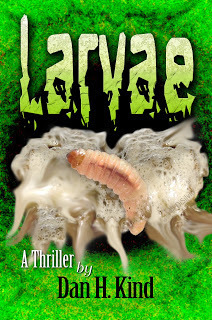
And try not to throw up all over your e-reader.

Published on May 15, 2012 23:23
May 13, 2012
Character Interview: Sitting Lotus
An interview with everybody's favorite Zen novice, Sitting Lotus, went live on World Literary Cafe today. So go check it out! Now, I say! ;)

[image error]

[image error]
Published on May 13, 2012 10:22
May 10, 2012
Twisted Myth Files (5): Nataraja
The Cosmic Dancer who dances Creation into and out of existence. "The Lord of the Dance." One of the many incarnations/aspects of the Hindu god Shiva.
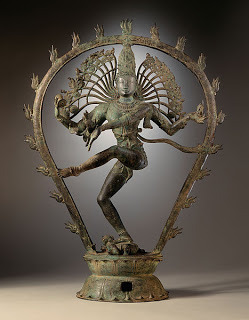
Most famous story: The sages living in the southern forest regions of India had attained great powers through meditation and ritual, but had grown arrogant and no longer praised the gods. So Shiva appeared in the forest as an ithyphallic mendicant named Bhikshatana and wandered about their villages, begging. Bhikshatana's . . . excitement . . . caused many of the sages' wives and daughters to become enamored with him, so the sages decided to use their powers to destroy this out-of-line beggar. First they summoned a fierce tiger made of fire, whose pelt Bhikshatana made into a loincloth. Next they sent a horde of poisonous snakes, which Bhikshatana hung about himself as jewelery. Then came a mad dwarf, which Bhikshatana stomped upon. (The twisted thing underneath Nataraja's feet in the depiction above is this wild dwarf.) A third eye formed in the beggar's forehead, two extra arms grew out from his torso, fire blazed into life in his upper left hand—and Shiva-as-Nataraja danced the Ananda Tanvara, which caused the monks to realize exactly who he was and recognize the error of their worship-neglecting ways.
The first depictions of Shiva as the Lord of the Dance appear in bronzes crafted in 10th - 12th century India. Nataraja is nowadays more a symbol than anything else, although he is to this day revered in India and elsewhere. As Ananda Coomaraswamy says in his essay "The Dance of Siva," "Whatever the origins of Siva's dance, it became in time the clearest image of the activity of God which any art or religion can boast of." To this day the Nataraja symbol be found in both Eastern and Western culture.
Powers and Abilities: Beyond comprehension. Not many mythological beings have the power of creation and destruction literally resting in the palm of their hand. Mythological beings gain their powers from ken, or "knowledge-of". The more well-known a mytho is in the great Mind of humankind, the more ken they have to utilize. Shiva-as-Nataraja may be to many just a symbol, but sometimes symbols have frightening power. Again, Coomaraswamy, "A great motif in religion or art, any great symbol, becomes all things to all men." As to whether or not Nataraja dancing the Samhara portion of his Ananda Tanvara could actually destroy the universe . . . well, we all know what happened in Eden last summer.
UPDATE - 5/9/12: This agent was on the scene for that scene, and that that ball of fire gripped in Nataraja's upper left hand is hot hot hot![image error]

Most famous story: The sages living in the southern forest regions of India had attained great powers through meditation and ritual, but had grown arrogant and no longer praised the gods. So Shiva appeared in the forest as an ithyphallic mendicant named Bhikshatana and wandered about their villages, begging. Bhikshatana's . . . excitement . . . caused many of the sages' wives and daughters to become enamored with him, so the sages decided to use their powers to destroy this out-of-line beggar. First they summoned a fierce tiger made of fire, whose pelt Bhikshatana made into a loincloth. Next they sent a horde of poisonous snakes, which Bhikshatana hung about himself as jewelery. Then came a mad dwarf, which Bhikshatana stomped upon. (The twisted thing underneath Nataraja's feet in the depiction above is this wild dwarf.) A third eye formed in the beggar's forehead, two extra arms grew out from his torso, fire blazed into life in his upper left hand—and Shiva-as-Nataraja danced the Ananda Tanvara, which caused the monks to realize exactly who he was and recognize the error of their worship-neglecting ways.
The first depictions of Shiva as the Lord of the Dance appear in bronzes crafted in 10th - 12th century India. Nataraja is nowadays more a symbol than anything else, although he is to this day revered in India and elsewhere. As Ananda Coomaraswamy says in his essay "The Dance of Siva," "Whatever the origins of Siva's dance, it became in time the clearest image of the activity of God which any art or religion can boast of." To this day the Nataraja symbol be found in both Eastern and Western culture.
Powers and Abilities: Beyond comprehension. Not many mythological beings have the power of creation and destruction literally resting in the palm of their hand. Mythological beings gain their powers from ken, or "knowledge-of". The more well-known a mytho is in the great Mind of humankind, the more ken they have to utilize. Shiva-as-Nataraja may be to many just a symbol, but sometimes symbols have frightening power. Again, Coomaraswamy, "A great motif in religion or art, any great symbol, becomes all things to all men." As to whether or not Nataraja dancing the Samhara portion of his Ananda Tanvara could actually destroy the universe . . . well, we all know what happened in Eden last summer.
UPDATE - 5/9/12: This agent was on the scene for that scene, and that that ball of fire gripped in Nataraja's upper left hand is hot hot hot![image error]
Published on May 10, 2012 17:31
April 30, 2012
Zen in the Debacle of Grammar: "Honey, that dribbly mud-man is eying me!" "You mean, eyeing you, dear."
This is one of those words that, when you say it, everybody knows what you're talking about. But writing it down, well, that's another story. A boring story with a 50-question, write-in-the-answer quiz afterwards. I started making one up but could only think of one question: "Which do you like, eying or eyeing?"
From the deep, meticulous research I've been undertaking for the last ten minutes or so, as far as I can tell no one can agree on this one. Something or other about "eying" being old English, and just not looking right on the page. According to this random online spell-checker, "eying" is wrong. But the spell-checker here on Blogger and the one on OpenOffice flag "eyeing" as incorrect. (Of course, they also say that dribbly is not a word, when it is.) Oxford Dictionary and Merriam-Webster say that both "eying" and "eyeing" are correct.
It seems to be a matter of preference, and no matter which spelling you decide to go with, there will likely be someone who objects. If one offends your sensibilities, just use the other and move on with your life. Don't, I repeat, don't, waste your time writing blog posts about it. (Oops. Too late.) Just be consistent. Don't do what I did in this blog post's title. If you use "eying" at one point in your novel, don't flip-flop to "eyeing" the next time around.
Thoughts? Condemnations? Readers and writers, which do you prefer, "eying" or "eyeing"? And more importantly, do you think "dribbly" can be used legitimately or is just sort of silly-sounding?
From the deep, meticulous research I've been undertaking for the last ten minutes or so, as far as I can tell no one can agree on this one. Something or other about "eying" being old English, and just not looking right on the page. According to this random online spell-checker, "eying" is wrong. But the spell-checker here on Blogger and the one on OpenOffice flag "eyeing" as incorrect. (Of course, they also say that dribbly is not a word, when it is.) Oxford Dictionary and Merriam-Webster say that both "eying" and "eyeing" are correct.
It seems to be a matter of preference, and no matter which spelling you decide to go with, there will likely be someone who objects. If one offends your sensibilities, just use the other and move on with your life. Don't, I repeat, don't, waste your time writing blog posts about it. (Oops. Too late.) Just be consistent. Don't do what I did in this blog post's title. If you use "eying" at one point in your novel, don't flip-flop to "eyeing" the next time around.
Thoughts? Condemnations? Readers and writers, which do you prefer, "eying" or "eyeing"? And more importantly, do you think "dribbly" can be used legitimately or is just sort of silly-sounding?
Published on April 30, 2012 03:00
April 28, 2012
Six Sunday - 4/29/2012 - From "The Fountain of Eden"

Team Myth walked up to the sipapuni, hidden deep within the sprawling natural wonder of Tranquil Forest. The morning rain had let up, and the sun now peeked through the clouds, portending yet another hot and humid August day. But this mattered not to Team Myth, for they would soon be out of this world. They stopped and stared at the effervescent spring, the entrance to the World Path.
"So what do we do?" asked Jack, eying the fizzling waterhole with skepticism. "Jump in and go for a swim?"
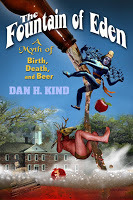
The scene above takes place just before Jack Whiskey and company descend to the ancient Greek Underworld to rescue a missing friend. Sipapuni, a Hopi Indian word that means "place of emergence", is what mythological beings call the Fountain of Youth.
"The Fountain of Eden" is just 99 cents on Amazon, Barnes & Noble, and Smashwords until May 1st. And please don't forget to head over to Six Sunday to check out the short, sweet posts from all the great writers. Until next time . . . peace out.
Published on April 28, 2012 21:24
April 26, 2012
Twisted Myth Files (4): Johnny Appleseed
Bringer of apples to the early American colonists. Born 1774, died 1845. One of the first heroes of American folklore. In life, a devout follower of the teachings of Emanuel Swedenborg.
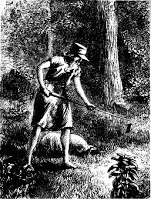
Most famous story: His life-story, although there is a dispute as to what purpose the apple orchards he left in his wake served: to eat . . . or to drink?
Powers and Abilities: (1) His feet are said to be so callused that he can walk over hot coals without feeling it. (2) Brews some damn good beer. The Olde Eden Brewery's Appleseed Applejack is so . . . tasty . . . that it, er, defies description.
Appleseed is the protector and ever-vigilant sentry of the town of Eden and the Fountain of Youth, which acts as a gateway between Earth and the myriad Worlds of Myth. How he obtained his intimate connection with the Fountain, often called the sipapuni by mythological beings, remains a mystery. The most popular theory is that in his wandering during the early 19th century the man John Chapman somehow found the sipapuni and drained a measure of his own blood into the spring, his life-fluid merging with the Water of Life. If this is true, all mythos, at least when we manifest on Earth, have a little Appleseed coursing through us. But the mythical jury is still convened on that one.
UPDATE - 4/25/12: Sometimes men transform into myths; oftentimes legend trumps real life. Keep in mind that the mythical Johnny Appleseed—and not the man John Chapman—is the owner of the Olde Eden Brewery & Taphouse. As an avatar of drunkenness, it is rumored that Appleseed has absorbed all the gods of wine, the vine, alcohol, etc. in existence into himself. If this is true (which in this agent's opinion is highly unlikely—although, come to think of it, I haven't seen Dionysus in some time), he is perhaps the most powerful mythological being residing on Earth. Regardless, he is to be treated as highly dangerous. Agents of the MythCourt, DO NOT ENGAGE.

Most famous story: His life-story, although there is a dispute as to what purpose the apple orchards he left in his wake served: to eat . . . or to drink?
Powers and Abilities: (1) His feet are said to be so callused that he can walk over hot coals without feeling it. (2) Brews some damn good beer. The Olde Eden Brewery's Appleseed Applejack is so . . . tasty . . . that it, er, defies description.
Appleseed is the protector and ever-vigilant sentry of the town of Eden and the Fountain of Youth, which acts as a gateway between Earth and the myriad Worlds of Myth. How he obtained his intimate connection with the Fountain, often called the sipapuni by mythological beings, remains a mystery. The most popular theory is that in his wandering during the early 19th century the man John Chapman somehow found the sipapuni and drained a measure of his own blood into the spring, his life-fluid merging with the Water of Life. If this is true, all mythos, at least when we manifest on Earth, have a little Appleseed coursing through us. But the mythical jury is still convened on that one.
UPDATE - 4/25/12: Sometimes men transform into myths; oftentimes legend trumps real life. Keep in mind that the mythical Johnny Appleseed—and not the man John Chapman—is the owner of the Olde Eden Brewery & Taphouse. As an avatar of drunkenness, it is rumored that Appleseed has absorbed all the gods of wine, the vine, alcohol, etc. in existence into himself. If this is true (which in this agent's opinion is highly unlikely—although, come to think of it, I haven't seen Dionysus in some time), he is perhaps the most powerful mythological being residing on Earth. Regardless, he is to be treated as highly dangerous. Agents of the MythCourt, DO NOT ENGAGE.
Published on April 26, 2012 07:02
April 24, 2012
End of April Sale!
Coinciding with the new blog series I've been running—the Twisted Myth files, which showcases the mythological characters from The Fountain of Eden: A Myth of Birth, Death, and Beer —for the remainder of the month of April the e-book will be discounted to 99 cents in the Kindle Store and at Barnes & Noble. So get yourself a copy while it's cheap! It's mythology, with a twist of hilariousness!
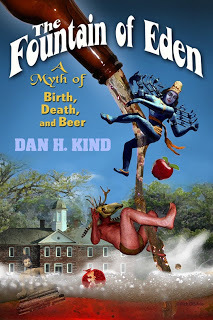


Published on April 24, 2012 12:57
April 23, 2012
Twisted Myth Files (3): Persephone
Iron Queen of the ancient Greek Underworld. Bride of Hades. Daughter of Zeus and Demeter.
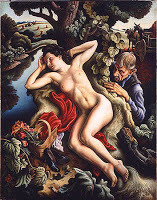 Most famous story: Her abduction. Persephone, a young goddess of Olympus, was out picking flowers one day. Hades, who had been lusting after her for some time, lured her away from her friends with the intoxicating scent of a narcissus flower. The earth opened up, and the King of the Dead dragged his unwilling new bride down to his Underworld domain. Her mother, Demeter, goddess of the Earth, was so distraught that she refused to bring about the springtime, and a harsh winter descended on the planet. After a time Zeus intervened in the vicious quarrel and convinced Hades to release Persephone. But while in the Underworld she swallowed the seeds of a pomegranate offered her by Hades. If one eats the food of the dead, one is cursed to stay in the Underworld forever. However, a compromise was reached in order to appease Demeter and get the seasons back in order. For eight months of the year Persephone would be free to roam the planet, but during the colder months she would be forced to remain in the Underworld. Check Ovid's Metamophoses and the Homeric Hymn to Demeter for a more detailed report.
Most famous story: Her abduction. Persephone, a young goddess of Olympus, was out picking flowers one day. Hades, who had been lusting after her for some time, lured her away from her friends with the intoxicating scent of a narcissus flower. The earth opened up, and the King of the Dead dragged his unwilling new bride down to his Underworld domain. Her mother, Demeter, goddess of the Earth, was so distraught that she refused to bring about the springtime, and a harsh winter descended on the planet. After a time Zeus intervened in the vicious quarrel and convinced Hades to release Persephone. But while in the Underworld she swallowed the seeds of a pomegranate offered her by Hades. If one eats the food of the dead, one is cursed to stay in the Underworld forever. However, a compromise was reached in order to appease Demeter and get the seasons back in order. For eight months of the year Persephone would be free to roam the planet, but during the colder months she would be forced to remain in the Underworld. Check Ovid's Metamophoses and the Homeric Hymn to Demeter for a more detailed report.
Powers and Abilities: As Persephone leaves Earth for the Underworld, winter sets over the land, and with her return she brings the spring. Therefore she is a goddess of both death and renewal, and she can both give life and take it with the brush of a finger. Any agents who attempt engagement should wear full body-armor, or an invisibility cloak, or douse themselves in enchanted invisible ink. Something, or you may end up back on your original World of Myth before you can say "narcissus".
UPDATE - 4/19/12: The Iron Queen has divorced Hades with the approval of the MythCourt. Hades has also agreed to release her from the Curse of Pomegranate so that she may remain on Earth full-time. For the past eight months she's been tending bar at the Olde Eden Brewery and Taphouse alongside new boyfriend Jack Whiskey. Agents of the MythCourt are closely monitoring their relationship.
 Most famous story: Her abduction. Persephone, a young goddess of Olympus, was out picking flowers one day. Hades, who had been lusting after her for some time, lured her away from her friends with the intoxicating scent of a narcissus flower. The earth opened up, and the King of the Dead dragged his unwilling new bride down to his Underworld domain. Her mother, Demeter, goddess of the Earth, was so distraught that she refused to bring about the springtime, and a harsh winter descended on the planet. After a time Zeus intervened in the vicious quarrel and convinced Hades to release Persephone. But while in the Underworld she swallowed the seeds of a pomegranate offered her by Hades. If one eats the food of the dead, one is cursed to stay in the Underworld forever. However, a compromise was reached in order to appease Demeter and get the seasons back in order. For eight months of the year Persephone would be free to roam the planet, but during the colder months she would be forced to remain in the Underworld. Check Ovid's Metamophoses and the Homeric Hymn to Demeter for a more detailed report.
Most famous story: Her abduction. Persephone, a young goddess of Olympus, was out picking flowers one day. Hades, who had been lusting after her for some time, lured her away from her friends with the intoxicating scent of a narcissus flower. The earth opened up, and the King of the Dead dragged his unwilling new bride down to his Underworld domain. Her mother, Demeter, goddess of the Earth, was so distraught that she refused to bring about the springtime, and a harsh winter descended on the planet. After a time Zeus intervened in the vicious quarrel and convinced Hades to release Persephone. But while in the Underworld she swallowed the seeds of a pomegranate offered her by Hades. If one eats the food of the dead, one is cursed to stay in the Underworld forever. However, a compromise was reached in order to appease Demeter and get the seasons back in order. For eight months of the year Persephone would be free to roam the planet, but during the colder months she would be forced to remain in the Underworld. Check Ovid's Metamophoses and the Homeric Hymn to Demeter for a more detailed report. Powers and Abilities: As Persephone leaves Earth for the Underworld, winter sets over the land, and with her return she brings the spring. Therefore she is a goddess of both death and renewal, and she can both give life and take it with the brush of a finger. Any agents who attempt engagement should wear full body-armor, or an invisibility cloak, or douse themselves in enchanted invisible ink. Something, or you may end up back on your original World of Myth before you can say "narcissus".
UPDATE - 4/19/12: The Iron Queen has divorced Hades with the approval of the MythCourt. Hades has also agreed to release her from the Curse of Pomegranate so that she may remain on Earth full-time. For the past eight months she's been tending bar at the Olde Eden Brewery and Taphouse alongside new boyfriend Jack Whiskey. Agents of the MythCourt are closely monitoring their relationship.
Published on April 23, 2012 19:25
April 14, 2012
Twisted Myth Files (2): Bodhidharma
"The One who Came from the West". Brought Zen practice from India to China in the 6th century CE. Direct dharma descendant of the Buddha. 28th Patriarch of Indian Buddhism. 1st Patriarch of Chinese Chán—which became Japanese Zen—Buddhism.
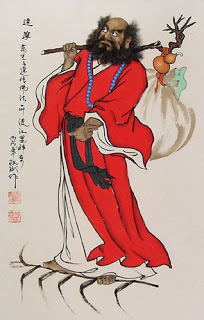
Most famous stories: (1) Encounter with Emperor Wu, where in response to the ruler's query as to the highest truth of Buddhism, he replies, "Vast emptiness, nothing holy." This is the first koan in the Blue Cliff Record. (2) The origins of the tea plant: Sometime during his nine-year-long wall-gazing session, Bodhidharma found himself struggling to stay awake during meditation. So he proceeded to cut off his eyelids. Where the eyelids hit the ground, strange new plants began to grow: tea plants. Since then Buddhist practitioners have used tea to help them stay awake and maintain concentration during meditation. (3) Three years after his death, Bodhidharma was seen walking in the Himalayas by a government official named Song Yun. The old monk was barefoot, carrying a pole with a single sandal mounted atop it. This wild story roused enough interests in the monks of Shaolin Monastery that they found cause to break open and enter the tomb where Bodhidharma was interred. The monk's remains were not there; all that was left in the tomb was a single sandal.
Powers and abilities: Unclear, except that he relies on some obscure power he calls "mind" as opposed to the pool of human imagination called "ken" that mythological beings draw upon to work their magic. An expert at kung-fu, it is widely believed that he is the inventor of the ancient martial art, which evolved from an exercise regimen called "The Eighteen Hands of Lohan" he invented during his time at Shaolin Monastery in China in the 6th century CE. Though he appears quite elderly, he is said to move fast when the situation calls for it.
UPDATE 4/14/12: Nowadays, head monk at New Shaolin Monastery in Eden, Virginia. It is also unclear whether Bodhidharma is human or mythological; with historical figures it's sometimes difficult to tell. The stories that he has no legs (which atrophied and fell off during his nine-year wall-meditation session), that he is in essence a human torso floating about the streets of Eden, must be wrong. Multiple MythCourt agents have reported seeing skinny legs shuffling underneath his patchwork robes. Some of them, after blowing their cover in no recognizable way, have even reported taking kicks to the face from feet attached to these allegedly nonexistent legs.[image error]

Most famous stories: (1) Encounter with Emperor Wu, where in response to the ruler's query as to the highest truth of Buddhism, he replies, "Vast emptiness, nothing holy." This is the first koan in the Blue Cliff Record. (2) The origins of the tea plant: Sometime during his nine-year-long wall-gazing session, Bodhidharma found himself struggling to stay awake during meditation. So he proceeded to cut off his eyelids. Where the eyelids hit the ground, strange new plants began to grow: tea plants. Since then Buddhist practitioners have used tea to help them stay awake and maintain concentration during meditation. (3) Three years after his death, Bodhidharma was seen walking in the Himalayas by a government official named Song Yun. The old monk was barefoot, carrying a pole with a single sandal mounted atop it. This wild story roused enough interests in the monks of Shaolin Monastery that they found cause to break open and enter the tomb where Bodhidharma was interred. The monk's remains were not there; all that was left in the tomb was a single sandal.
Powers and abilities: Unclear, except that he relies on some obscure power he calls "mind" as opposed to the pool of human imagination called "ken" that mythological beings draw upon to work their magic. An expert at kung-fu, it is widely believed that he is the inventor of the ancient martial art, which evolved from an exercise regimen called "The Eighteen Hands of Lohan" he invented during his time at Shaolin Monastery in China in the 6th century CE. Though he appears quite elderly, he is said to move fast when the situation calls for it.
UPDATE 4/14/12: Nowadays, head monk at New Shaolin Monastery in Eden, Virginia. It is also unclear whether Bodhidharma is human or mythological; with historical figures it's sometimes difficult to tell. The stories that he has no legs (which atrophied and fell off during his nine-year wall-meditation session), that he is in essence a human torso floating about the streets of Eden, must be wrong. Multiple MythCourt agents have reported seeing skinny legs shuffling underneath his patchwork robes. Some of them, after blowing their cover in no recognizable way, have even reported taking kicks to the face from feet attached to these allegedly nonexistent legs.[image error]
Published on April 14, 2012 16:08



